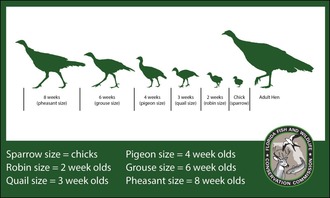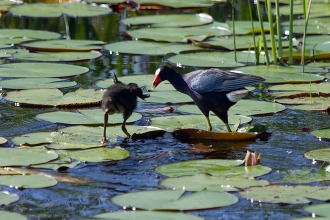 Chart used to estimate the age of Wild Turkey poults.
In the last few months birders may have noticed some smaller additions to the flocks of Wild Turkeys commonly observed throughout the state. Florida’s Wild Turkeys begin breeding in late February and early March, nesting until June in shallow depressions where they lay nine to twelve eggs over about two weeks. After 26 to 28 days of continuous incubation by their mother, the eggs hatch. Baby turkeys are called poults and grow from the size of a sparrow to the size of a pheasant in about eight weeks before reaching full adult size. They can feed themselves soon after hatching, eating mainly insects to get enough protein to sustain their rapid growth, and can fly after just two to four weeks. Nesting success and brood survival can vary each year based on factors like weather conditions, predation and habitat quality. These yearly changes can have a strong impact on Wild Turkey populations in following years.
You can help Wild Turkey populations continue to thrive by participating in the Summer Brood Survey. Anyone who sees a Wild Turkey can do it. Simply make a report of any Wild Turkeys (both adults and poults) seen between June 1st and August 31st using a simple online form, found here. By reporting sightings, you'll be helping scientists gauge Wild Turkey nesting success, brood survival and population dynamics at statewide and regional levels.
Learn more about Wild Turkeys here, and learn more about the survey here.
 Mother and juvenile Purple Gallinules at Savannas Preserve State Park. Photo by Travis Blunden.
 |
Great Florida Birding and Wildlife Trail staff recently visited Savannas Preserve State Park in Port St. Lucie, an excellent place to see Purple Gallinules. The birds are easy to find. From the park’s main entrance on Walton Road head to the kayak launch, down the 0.75-mile drivable trail left of the visitor center. Few things are as beautiful as Purple Gallinules in the sunlight, rainbow colors glowing as they walk nimbly through vegetation on the muddy edges of fresh water. We found out that during the morning the gallinules are backlit by the sunrise, so if you're looking to capture those colors with your camera, the afternoon and evening are the best chance for a perfect shot. That morning we were lucky enough to see several adults and young juveniles with their mother. This section of the park also features a charming picnic area, excellent water views, and up-close access to other birds like Common Gallinules, Sandhill Cranes, ducks and more.
Savannas Preserve State Park protects 5,400 acres of mainly basin marsh ecosystem, a type of relatively deep freshwater wetland that was common in South Florida before suburban growth. This type of ecosystem is home to attractive plants like white waterlily, American lotus and pickerelweed, as well as many wading birds and other species that thrive in wet environments. Those looking for a bit of adventure should visit the park’s Hawks Bluff Nature Trail off County Line Road/Savannah Road, a one-mile hike that reaches elevations of 40 feet on the Atlantic Coastal Scrub Ridge, a rare experience in Florida.
The park hosts many guided interpretive programs at varied difficulty levels, including paddling and hiking tours. Although the park’s visitor center is currently closed, these programs remain active. Learn more about them here, and learn more about birding at the site on our website.
 Sunset seen from the newly reopened observation tower at Big Lagoon State Park. Photo by Florida State Parks.
The Florida Department of Environmental Protection (DEP) is excited to reopen amenities at Big Lagoon State Park in Pensacola. The park sustained significant damage to its roads, pavilions, boardwalks and observation tower from Hurricane Sally. Through the hard work of construction crews and Florida State Parks staff and volunteers, several big restoration projects were completed, and 207 tons of debris were hauled away, allowing full access to the amenities within this beautiful state park.
The completed projects include road improvements; repairing or replacing walkways at the West, South and North boardwalks; and repairing or replacing decking, stairs, walls and/or roofs at three pavilions and the observation tower. Located at the eastern-most accessible part of the park, the observation tower is situated between the two natural communities: the marsh area surrounding Grand Lagoon and the intracoastal waterway that is a part of Big Lagoon. The tower provides an exceptional vantage point for birdwatching. Clapper rails, great blue herons, terns, skimmers, brown pelicans, ospreys and bald eagles make this habitat home. Other wildlife that can be spotted here include dolphins, manatees, coyotes, foxes, deer and gopher tortoises.
Big Lagoon State Park is a Gateway site on the Great Florida Birding and Wildlife Trail. Learn more about birding at the park here.
|